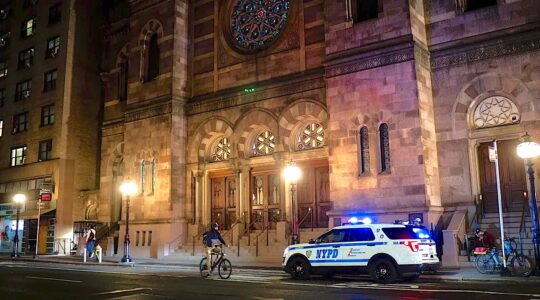On Manhattan’s Upper West Side, Saturday morning around 8:45 is a wonderful time to be Jewish. For there, against a background of catch-the-worm exercisers, snoozy coffee sippers and direction-challenged tourists, Jews of all denominations, beliefs, customs and practice wend their way towards worship, ever so briefly turning Broadway into Shabbatway.
I see them every week: that father and son in matching dark suits, the elder toting a tallis in protective plastic; that bearded gent in white shirt and khakis; those two bochers sporting personalized kippot and planning their Facebook updates; a stately young mother, hair in kerchief, whose leotard top modestly covers arms deftly steering a baby carriage; a lithe kipa-covered man carrying a yoga mat.
Participating in this multicolored parade of Jews of all kinds, you can’t help but feel part of something enormous — a large and holy project that comes from practicing our religion, each in our own way, but together in time and space. But that feeling vanishes as we scatter to our respective synagogues like pool balls into the pockets of a billiard table after a skillful break.
And yet…
Something of that elusive sense of unity can be found on Rosh HaShanah, one of the holiest days of the Jewish year. It’s there during the rite of tashlich, which means “cast away.” In this ritual of atonement, on the first afternoon of the holiday (or second should the first fall on Shabbat), we throw crumbs of bread, symbolizing our sins, into a flowing body of water.
In years past, tashlich has been played for its exotic strangeness, too frequently stereotyped by the clichéd depiction of chasidim throwing bread from a pier.
But along the Hudson River, this ritual of medieval origin, perhaps inadvertently, reinvents itself for the 21st century. Come to Riverside Park around 91st Street and see what I mean.
From a tree-canopied Riverside Drive, you descend past skateboarders noisily clattering around the semi-grand Soldier’s and Sailor’s Monument, alongside the community garden florally bedecking the park’s promenade, down a set of stairs until finally the gleaming Hudson comes into view.
The Torah has been likened to flowing water. If so, then the Hudson is the Torah of New York, inspiring painters and poets, technological innovation and, thanks to a clean up, boaters and yes, even swimmers.
Thanks to recent renovations, which have made access to the river much easier, as you walk under the Henry Hudson Parkway Bridge and approach the Hudson itself, a spectacular panoramic view of the river and the Palisades that border it unfurls like a Torah scroll.
More often than not, the tashlich gathering benefits from the city’s best early autumn weather. Fluffy cotton puff clouds gambol through jewel-like turquoise skies. The setting sun gradually turns from bright gold to blood orange red, glowing so warmly you want to paint a smiley face on it. And that warmth is moderated by cooling river breezes, which makes it easy to contemplate the big questions — who am I? How can I be a better person? How much is that Fort Lee high-rise co-op across the river?
Keep on walking and experience a veritable Hudson River Shul of Religious Expression. Throngs of Jews of all sorts line the wooden railing along the river, stroll the asphalt walk with friends, lounge on wooden park benches.
Support the New York Jewish Week
Our nonprofit newsroom depends on readers like you. Make a donation now to support independent Jewish journalism in New York.
Over there is a huge family in holiday finery, antsy kids momentarily mollified by snacks. Facing east and away from the river, a man in a knitted kipa and shorts shuckles, davening Mincha. Nearby, a teenage boy and girl flirt with each other by mildly mocking the proceedings.
Yes, it can be sceney, shmoozy and pick-uppy, but as you get to the railing lining the river, the meaning of the day and that majestic view of the Hudson take over. Despite the crowd, participants position themselves a respectful distance from each other giving each nefesh, each soul, its space. A young woman in a flowing skirt weeps as she arcs her symbolic crumbs of sin into the river. Another young woman, this one with her dog, quickly tosses her bread before the pooch can claim it as a treat. Many worshippers just stand and stare and shed their morsels one by one as if recounting sin after sin, misgiving after misgiving after misgiving.
This being New York, however, some rudeness can spoil the vibe. There’s the resentment and downright hostility displayed by some possessive parkgoers, particularly those on wheels, inconvenienced or displaced by this gathering. Once, I actually had to place my body between one irate biker and a late-middle-aged couple escorting an old woman with a cane whom the biker was threatening to run down for some perceived slight. That’ll crack your kavannah.
Then there was that unique tashlich 11 years ago, just days after the attack on the World Trade Center. Over the Hudson were the same skies as on the tragic day, skies almost mocking in their pristine beauty. For many, it was their first opportunity to come together as a Jewish community. Some stared across the river hollow-eyed, still dazed. Far more tears than breadcrumbs fell that afternoon, more sobs and embraces than prayers. Expiation gave way to consolation. How healing it was to mark the attack of an iconic landmark by gathering at another.
But the marvel of tashlich on the Hudson is that you don’t need a tragedy to realize your commonality. All you need to do is look within and look around.
As I take my turn by the railing, I see that despite coming from so many flavors of Jewish, those symbols of transgression, those breadcrumbs clotting the river’s surface look pretty much the same. And truth be told, like sin itself, none too attractive.
So with that, I cast away the crumbs of sin, resolving to be a better person in the coming year. And I take away the crumbs of unity I feel with you and you and you, resolving to be a better Jew for the sake of our city, our community, our world and God, knowing ineluctably, I’ll come up short; God willing, I’ll be back at the riverside next year to do it all again. Maybe even standing next to you. ◆
Jeff Yablonka is a writer living in New York. He was a regular contributor to The Jewish Week’s journal Text/Context.
The New York Jewish Week brings you the stories behind the headlines, keeping you connected to Jewish life in New York. Help sustain the reporting you trust by donating today.




